Cheol Young Park
A Study of Machine Learning Models in Predicting the Intention of Adolescents to Smoke Cigarettes
Oct 31, 2019

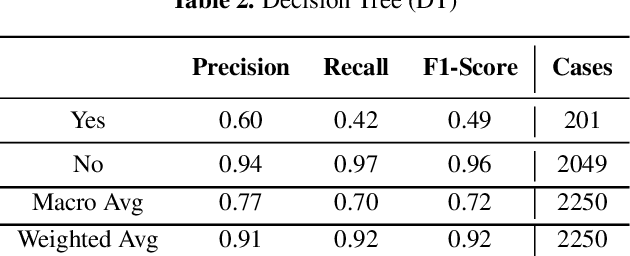

Abstract:The use of electronic cigarette (e-cigarette) is increasing among adolescents. This is problematic since consuming nicotine at an early age can cause harmful effects in developing teenager's brain and health. Additionally, the use of e-cigarette has a possibility of leading to the use of cigarettes, which is more severe. There were many researches about e-cigarette and cigarette that mostly focused on finding and analyzing causes of smoking using conventional statistics. However, there is a lack of research on developing prediction models, which is more applicable to anti-smoking campaign, about e-cigarette and cigarette. In this paper, we research the prediction models that can be used to predict an individual e-cigarette user's (including non-e-cigarette users) intention to smoke cigarettes, so that one can be early informed about the risk of going down the path of smoking cigarettes. To construct the prediction models, five machine learning (ML) algorithms are exploited and tested for their accuracy in predicting the intention to smoke cigarettes among never smokers using data from the 2018 National Youth Tobacco Survey (NYTS). In our investigation, the Gradient Boosting Classifier, one of the prediction models, shows the highest accuracy out of all the other models. Also, with the best prediction model, we made a public website that enables users to input information to predict their intentions of smoking cigarettes.
Predictive Situation Awareness for Ebola Virus Disease using a Collective Intelligence Multi-Model Integration Platform: Bayes Cloud
May 04, 2019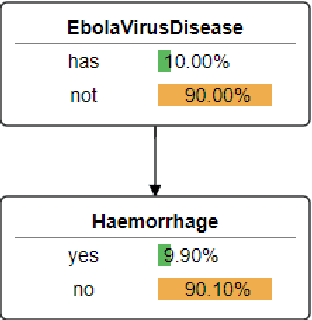
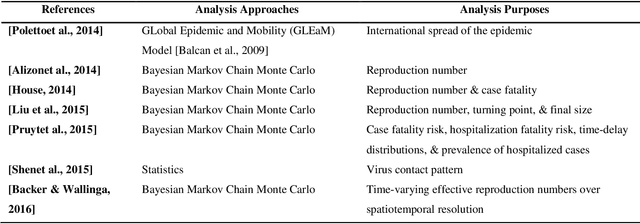
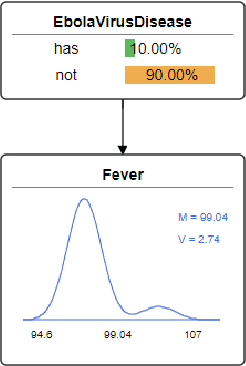
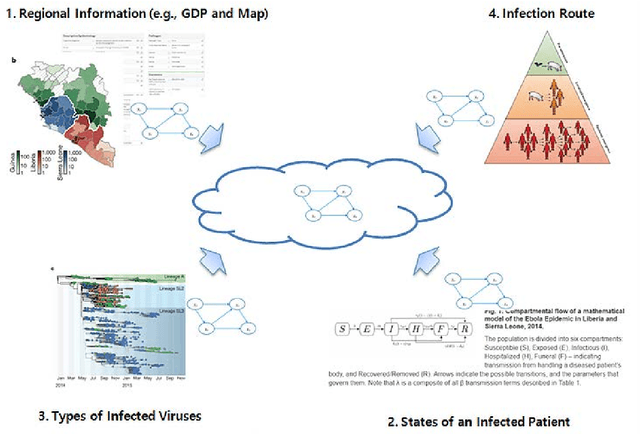
Abstract:The humanity has been facing a plethora of challenges associated with infectious diseases, which kill more than 6 million people a year. Although continuous efforts have been applied to relieve the potential damages from such misfortunate events, it is unquestionable that there are many persisting challenges yet to overcome. One related issue we particularly address here is the assessment and prediction of such epidemics. In this field of study, traditional and ad-hoc models frequently fail to provide proper predictive situation awareness (PSAW), characterized by understanding the current situations and predicting the future situations. Comprehensive PSAW for infectious disease can support decision making and help to hinder disease spread. In this paper, we develop a computing system platform focusing on collective intelligence causal modeling, in order to support PSAW in the domain of infectious disease. Analyses of global epidemics require integration of multiple different data and models, which can be originated from multiple independent researchers. These models should be integrated to accurately assess and predict the infectious disease in terms of holistic view. The system shall provide three main functions: (1) collaborative causal modeling, (2) causal model integration, and (3) causal model reasoning. These functions are supported by subject-matter expert and artificial intelligence (AI), with uncertainty treatment. Subject-matter experts, as collective intelligence, develop causal models and integrate them as one joint causal model. The integrated causal model shall be used to reason about: (1) the past, regarding how the causal factors have occurred; (2) the present, regarding how the spread is going now; and (3) the future, regarding how it will proceed. Finally, we introduce one use case of predictive situation awareness for the Ebola virus disease.
Reference Model of Multi-Entity Bayesian Networks for Predictive Situation Awareness
Jun 08, 2018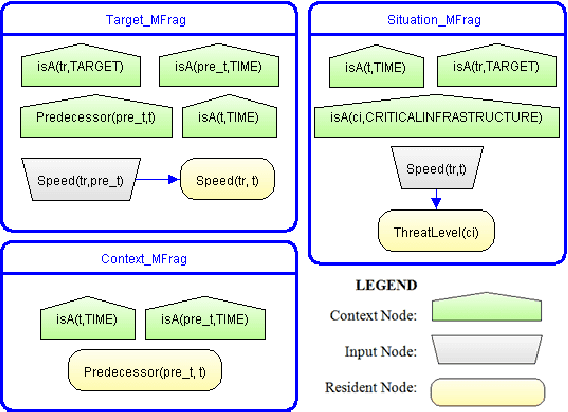



Abstract:During the past quarter-century, situation awareness (SAW) has become a critical research theme, because of its importance. Since the concept of SAW was first introduced during World War I, various versions of SAW have been researched and introduced. Predictive Situation Awareness (PSAW) focuses on the ability to predict aspects of a temporally evolving situation over time. PSAW requires a formal representation and a reasoning method using such a representation. A Multi-Entity Bayesian Network (MEBN) is a knowledge representation formalism combining Bayesian Networks (BN) with First-Order Logic (FOL). MEBN can be used to represent uncertain situations (supported by BN) as well as complex situations (supported by FOL). Also, efficient reasoning algorithms for MEBN have been developed. MEBN can be a formal representation to support PSAW and has been used for several PSAW systems. Although several MEBN applications for PSAW exist, very little work can be found in the literature that attempts to generalize a MEBN model to support PSAW. In this research, we define a reference model for MEBN in PSAW, called a PSAW-MEBN reference model. The PSAW-MEBN reference model enables us to easily develop a MEBN model for PSAW by supporting the design of a MEBN model for PSAW. In this research, we introduce two example use cases using the PSAW-MEBN reference model to develop MEBN models to support PSAW: a Smart Manufacturing System and a Maritime Domain Awareness System.
MEBN-RM: A Mapping between Multi-Entity Bayesian Network and Relational Model
Jun 08, 2018



Abstract:Multi-Entity Bayesian Network (MEBN) is a knowledge representation formalism combining Bayesian Networks (BN) with First-Order Logic (FOL). MEBN has sufficient expressive power for general-purpose knowledge representation and reasoning. Developing a MEBN model to support a given application is a challenge, requiring definition of entities, relationships, random variables, conditional dependence relationships, and probability distributions. When available, data can be invaluable both to improve performance and to streamline development. By far the most common format for available data is the relational database (RDB). Relational databases describe and organize data according to the Relational Model (RM). Developing a MEBN model from data stored in an RDB therefore requires mapping between the two formalisms. This paper presents MEBN-RM, a set of mapping rules between key elements of MEBN and RM. We identify links between the two languages (RM and MEBN) and define four levels of mapping from elements of RM to elements of MEBN. These definitions are implemented in the MEBN-RM algorithm, which converts a relational schema in RM to a partial MEBN model. Through this research, the software has been released as a MEBN-RM open-source software tool. The method is illustrated through two example use cases using MEBN-RM to develop MEBN models: a Critical Infrastructure Defense System and a Smart Manufacturing System.
Human-aided Multi-Entity Bayesian Networks Learning from Relational Data
Jun 06, 2018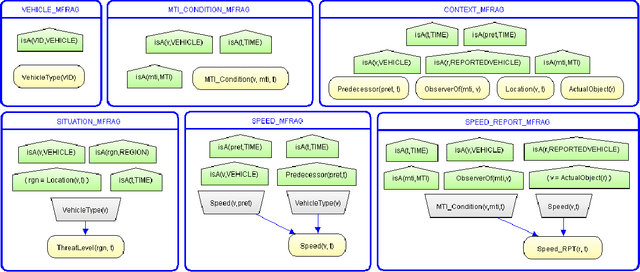

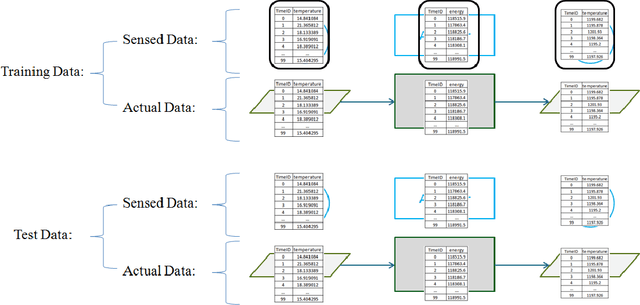

Abstract:An Artificial Intelligence (AI) system is an autonomous system which emulates human mental and physical activities such as Observe, Orient, Decide, and Act, called the OODA process. An AI system performing the OODA process requires a semantically rich representation to handle a complex real world situation and ability to reason under uncertainty about the situation. Multi-Entity Bayesian Networks (MEBNs) combines First-Order Logic with Bayesian Networks for representing and reasoning about uncertainty in complex, knowledge-rich domains. MEBN goes beyond standard Bayesian networks to enable reasoning about an unknown number of entities interacting with each other in various types of relationships, a key requirement for the OODA process of an AI system. MEBN models have heretofore been constructed manually by a domain expert. However, manual MEBN modeling is labor-intensive and insufficiently agile. To address these problems, an efficient method is needed for MEBN modeling. One of the methods is to use machine learning to learn a MEBN model in whole or in part from data. In the era of Big Data, data-rich environments, characterized by uncertainty and complexity, have become ubiquitous. The larger the data sample is, the more accurate the results of the machine learning approach can be. Therefore, machine learning has potential to improve the quality of MEBN models as well as the effectiveness for MEBN modeling. In this research, we study a MEBN learning framework to develop a MEBN model from a combination of domain expert's knowledge and data. To evaluate the MEBN learning framework, we conduct an experiment to compare the MEBN learning framework and the existing manual MEBN modeling in terms of development efficiency.
Gaussian Mixture Reduction for Time-Constrained Approximate Inference in Hybrid Bayesian Networks
Jun 06, 2018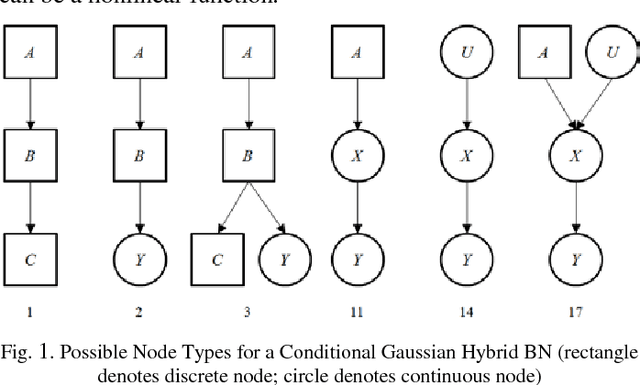

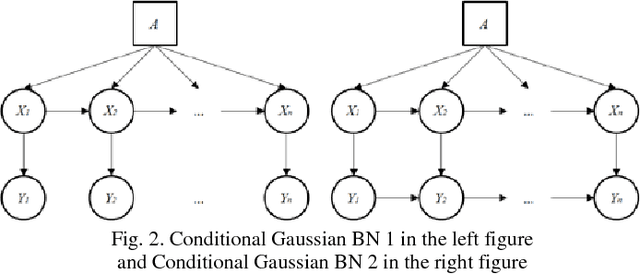

Abstract:Hybrid Bayesian Networks (HBNs), which contain both discrete and continuous variables, arise naturally in many application areas (e.g., image understanding, data fusion, medical diagnosis, fraud detection). This paper concerns inference in an important subclass of HBNs, the conditional Gaussian (CG) networks, in which all continuous random variables have Gaussian distributions and all children of continuous random variables must be continuous. Inference in CG networks can be NP-hard even for special-case structures, such as poly-trees, where inference in discrete Bayesian networks can be performed in polynomial time. Therefore, approximate inference is required. In approximate inference, it is often necessary to trade off accuracy against solution time. This paper presents an extension to the Hybrid Message Passing inference algorithm for general CG networks and an algorithm for optimizing its accuracy given a bound on computation time. The extended algorithm uses Gaussian mixture reduction to prevent an exponential increase in the number of Gaussian mixture components. The trade-off algorithm performs pre-processing to find optimal run-time settings for the extended algorithm. Experimental results for four CG networks compare performance of the extended algorithm with existing algorithms and show the optimal settings for these CG networks.
 Add to Chrome
Add to Chrome Add to Firefox
Add to Firefox Add to Edge
Add to Edge